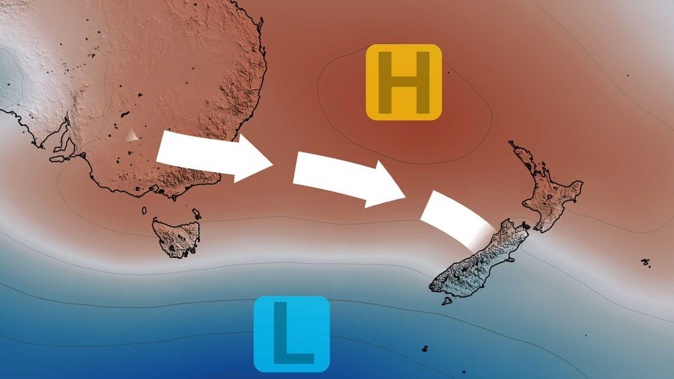
New Zealand’s climate is about to take a “rapid turn”, a meteorologist says, giving Kiwis a taste of the hotter, drier summer much of the country will experience under El Niño.
There’s now also a good chance the long-anticipated climate system - which could be formally declared within weeks - will sit among the strongest El Niños seen in the past 80 years, with officials already warning of fire danger and a heightened risk of drought.
For those regions hit hardest by the relentless rain and humidity of three years of La Niña, its counterpart climate driver is expected to bring the reverse set-up, with long periods of summer heat and dryness fanned by persistent westerly flows.
“Using the data from August, this El Niño is in with the five strongest that have occurred in the last eight decades,” Niwa meteorologist Ben Noll said.
Several of those events came with major dry spells: notably the El Niño summers of 1972/73, 1982/83 and 1997-98, when a horror event cost the country hundreds of millions of dollars.
“With its potential intensity being up there with those historically-significant events, there’s definitely a few flags starting to be thrown.”
This El Niño - our first since 2016 - would also come against a background of climate change, and in tandem with another natural driver that had a hand in Australia’s catastrophic bushfires of 2019-20: a positive phase of what’s called the Indian Ocean Dipole.
“This could dramatically reduce the chance of seeing those tropical moisture plumes as we look ahead - so it’s kind of a double-whammy of climate drivers that are going to be coming on quite strongly,” Noll said.
Before that, however, Noll said things would take a turn within a few weeks, when the atmosphere “coupled” with oceans already in an El Niño-like state.
“In a New Zealand context, this is going to mean that our own weather patterns are likely to take a rapid turn toward an El Niño-like pattern - and that’s expected to start in the second half of September.”
- El Nino conditions create devastating effects for Pacific nations
- El Niño is here and the world must prepare for more extreme heat, UN weather agency warns
- The oceans just reached their hottest temperature on record as El Niño looms. Here are 6 things to watch for
- Strong La Niñas and El Niños becoming more frequent as climate changes
As Niwa picked in its recently-issued spring outlook, Noll expected to see a significant shift in the frequency and intensity of westerly winds, spelling below-normal rainfall and frequently-warm temperatures for the east of both islands.
“We could be seeing days exceeding 25C during the second half of September,” he said.
“By the end of this month, or by mid-October, I think we’ll really have had our first real taste of this El Niño event, and what’s to come for the rest of 2023.
/cloudfront-ap-southeast-2.images.arcpublishing.com/nzme/UN5TLM3X37W3RJZHJNJDY46VFM.jpg)
An incoming El Nino system is raising the risk of drought and wildfire in eastern regions this summer. Photo / Alan Gibson
“For the likes of Canterbury, eastern Marlborough, northern Otago, Wairarapa and Hawke’s Bay, but also the Bay of Plenty, Coromandel, Auckland and Northland, the weather is going to be quite a contrast to what we’ve dealt with the last couple of springs and summers.
“So, it’s about being prepared for the kind of extremes that are going to be possible for the next six months.”
In Hawke’s Bay, rainfall had already been running at half the normal average, with indications of even drier trends for late September and early October - although a high amount of moisture left in the ground meant there was no imminent threat of local drought.
Hawke’s Bay Regional Council acting science manager Dr Kathleen Kozyniak said it was too early to say if that’d happen this summer - but the developing pattern did point to a heightened risk.
“As usual, we’ll be closely monitoring weather patterns and the status of the region’s rainfall and soil moisture and sharing information through our website and monthly state-of-the-environment reporting,” Kozyniak told NZME.
Fire and Emergency New Zealand’s (Fenz) service delivery wildfire manager Tim Mitchell said conditions forecast for summer were likely to come with higher levels of fire danger on the east coasts of both islands.
/cloudfront-ap-southeast-2.images.arcpublishing.com/nzme/67INUOD7EZBH5FK32AX5JWQZZA.jpg)
Image / Fire and Emergency New Zealand
“Given this year’s flood events and wet conditions, people will likely find it difficult to understand the wildfire risk New Zealand could be facing soon,” Mitchell said.
“But a spell of hot dry windy weather will quickly dry out the grass and vegetation that has grown and will likely grow over the coming months, due to the moist soils and return to warmer weather.
/cloudfront-ap-southeast-2.images.arcpublishing.com/nzme/HV5D2KA2KBE7XKPXEOJ45BKFOA.jpg)
Image / Fire and Emergency NZ
“This will become a fire risk if not managed.”
Fenz was urging people in rural and semi-rural areas to prepare now by keeping grass short, moving flammable materials well away from their homes, clearing gutters and accessways to ensure rapid address numbers were visible, and having a plan of action ready.
“Ninety-eight per cent of New Zealand wildfires are caused by people and people can do a great deal to prevent wildfires occurring and to help protect themselves and their property.”
Jamie Morton is a specialist in science and environmental reporting. He joined the Herald in 2011 and writes about everything from conservation and climate change to natural hazards and new technology.
Take your Radio, Podcasts and Music with you









